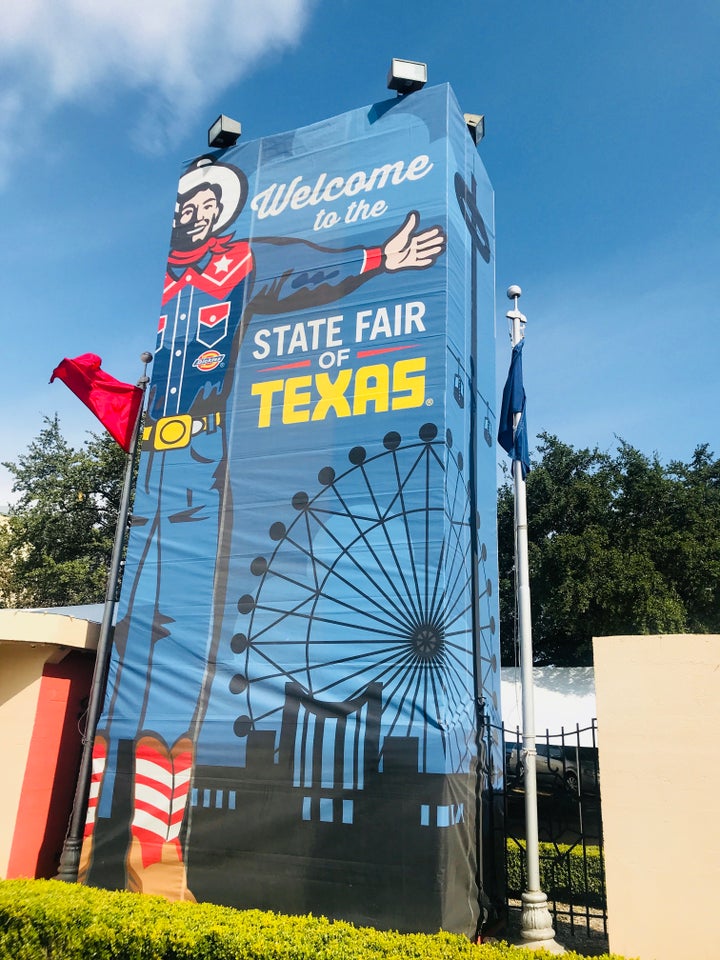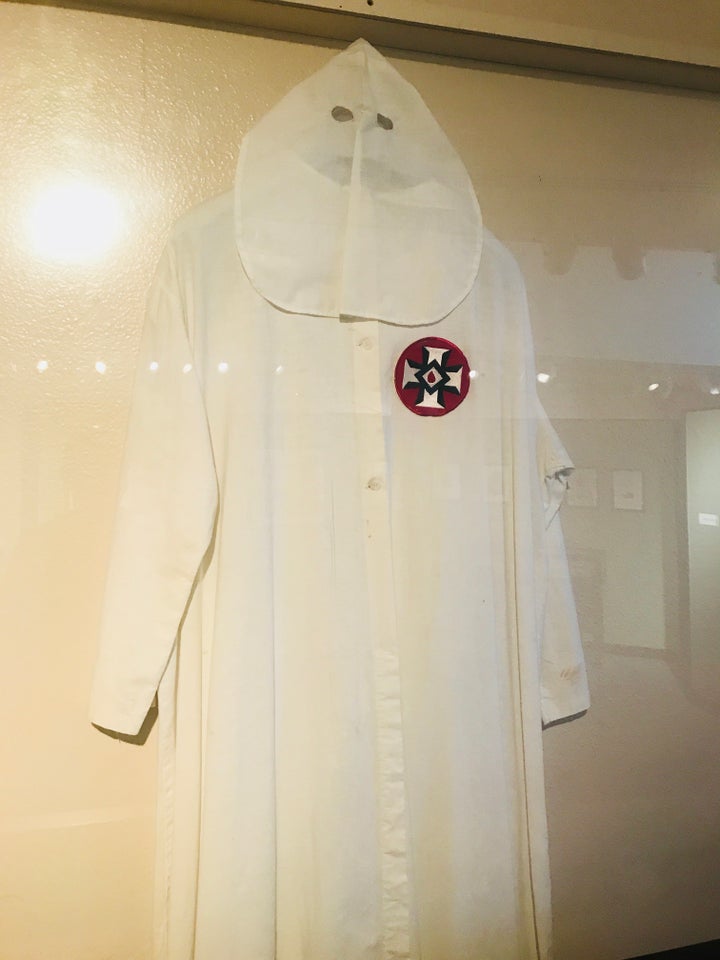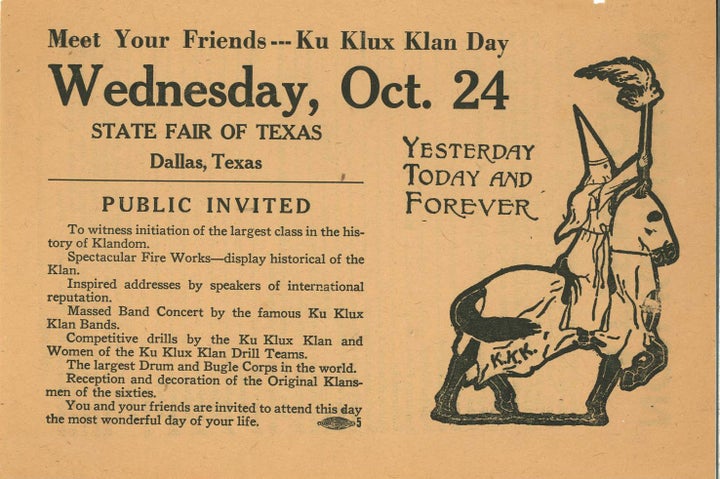“You’re in South Dallas now.”
My elderly Uber driver announced our location, carefully stopping at gate after closed gate, unable to enter Fair Park, home of the annual State Fair of Texas.
“One of them has to be open,” he mumbled, interrupting his own story about the Hurricane Katrina evacuees responsible for the neighborhood’s decline. As I focused on boarded-up buildings that appeared to be ripe for gentrification, he hit the brakes abruptly to drop me off by a three-story, bright blue sign featuring a smiling, wholesome cowboy that read: ”Welcome to the State Fair of Texas.”

Repugnant history can smack us in the face anywhere and at any time. It strikes deeper when it feels personal. I love to explore new cities on my own, but I am hyper-aware of my surroundings and the fact that I might stand out. I’m half-black and I wear exaggerated, thick-framed glasses.
While my girlfriend attended a convention in Dallas, I spent two days alone in the city, which is home to an active Ku Klux Klan chapter that at its peak in the 1920s boasted the largest membership in the country, and its then Imperial Wizard, Hiram W. Evans, was a resident.
I immediately felt that I was trespassing. The fair had just ended a few days earlier. There was no welcome booth or informative map. I relied upon my phone to point me to my destinations, each of which was located on the grounds. The Dallas Historical Society, The African American Museum and The Women’s Museum were spread out on the nearly 300-acre park, which includes the 92,000-seat Cotton Bowl stadium.
The chilly autumn breeze was visible on the faces of the first people I saw while traversing the seemingly abandoned park. A crew of four men, each slightly overweight, sulked as they dismantled a booth whose stars-and-stripes sign beaconed fairgoers to buy Fried Mexican Firecrackers, Chili Cheese Fries and Fried Fritos™ Pie Bites.
I nodded subtly, but they didn’t reciprocate. I began to feel invisible walking through the timeless landscape of hundred-year-old trees and colorful flower beds. The park felt ominous, as a forklift operated by a dull-eyed driver hummed by, reminding me — not in a comforting way — that I wasn’t alone.
The African American Museum looked closed, but a tug on the door led me to a man in his 70s with a receding gray afro. He sat quietly, reading behind a desk in the silent foyer.
“Right up the stairs.” He smiled and waved his hand toward a staircase that led me to five small wings, each containing a different exhibit. I joined a small group of schoolchildren who gazed patiently at ancient African art, and I wandered alone through a photo exhibit before encountering something that piqued my interest: an exhibit on Freedman’s Town, a post-Reconstruction, thriving black community in Dallas. Photographs of proud people owning homes, running businesses and living happy lives warmed my heart. Artifacts filled glass cases and told triumphant stories. Then I came face to face with horror.
In a glass frame immediately in front of me was a Ku Klux Klan robe and hood. The white, drapey uniform brandished a blood-red patch over its heart, with a white and black cross-like insignia.

This was worn by just some normal guy, was my first thought. That’s what frightened me the most. I’d been reading a lot about the Klan recently, and I knew that this wasn’t the uniform of a leader; it was that of a follower. Someone who, in the early 1920s, had decided to become one of millions of Americans who joined the Klan during its massive second wave.
Though two-dimensional inside its frame, the uniform felt remarkably lifelike. The hood’s beady eye-holes naturally pulled me in, and we stared at one another for what felt like a long time. I wondered what had been seen through those eye-holes. The robe was spotless, but I considered how many people may have been lynched, kidnapped, raped, tarred-and-feathered, branded, shot, whipped or maimed by the man who wore it.
I’d never experienced this kind of confrontation before. I tasted the stinging threat of something or someone I’d been conditioned to fear. At the same time, I was conscious that it was merely an inanimate representation — a symbol that had been deliberately ― perhaps strategically ― placed in a space that until that moment had felt peaceful and safe.
I left the museum feeling nauseated and heartbroken, and my remaining time in Fair Park felt futile. I was unable to fully appreciate the magnificent architecture of the 1930s Art Deco buildings I’d come to see. The beautifully imposing Dallas Historical Society was closed for the day, and the equally impressive Women’s Museum had closed permanently in 2011.
“The robe was spotless, but I considered how many people may have been lynched, kidnapped, raped, tarred-and-feathered, branded, shot, whipped or maimed by the man who wore it.”
I felt vulnerably non-white as I walked briskly out of the park, nervously passing two white security guards whom I would have barely noticed under normal circumstances. I mentally placed a pointy white hood on every person I saw on the street as I walked, wishing I’d felt as invisible as I had earlier.
I could not have chosen a better lunch destination — a much needed cleanse at Kalachandji’s vegetarian buffet inside a Hare Krishna temple, where I felt safely surrounded by dozens of welcoming people. There I did some research. It turns out some very bad things had happened at Fair Park.
In November 1922, Evans succeeded William Simmons as the Ku Klux Klan’s Imperial Wizard. Membership reached an all-time high under Evans’ reign, and, according to one report, it “presumably represented about one out of three eligible men in Dallas.” The Texas Klan used its power to help elect sheriffs, district attorneys and judges, and it operated from its headquarters on South Elm Street, just outside Fair Park.
“Klan Day” was held in Fair Park on Oct. 24, 1923. An estimated 160,000 Klansmen attended the festivities, and in the evening, 25,000 members held the largest initiation ceremony in the Klan’s history, adding 5,631 men and 800 women into their ranks. At the event, Evans delivered an address titled ″The Menace of Modern Immigration.” It’s hard to believe that 94 years of history have not forced such ideology that fueled this address further underground. We now hear sentiments like this every day at events that are far more mainstream and public than “Klan Day.”

I pondered how much ― and how little ― Fair Park had changed in the 94 years since “Klan Day.” Though Fair Park’s website currently advertises a concert by a Hindu singer and features many diverse faces, it’s likely that the same trees towering over me had once been frail twigs observing a robed army. I looked around the restaurant where I was eating, taking in the diverse clientele, and realized that many of us would have been denied entry to Fair Park until it was forced by court order to integrate in 1961.
I live in a bubble in Brooklyn, New York, where I never see a Confederate flag bumper sticker on a pickup truck, an ad for a gun show or a homemade anti-abortion billboard. Despite causing me to feel threatened, discouraged and uneasy, these iconic images ― all of which I did see during my visit to Texas ― are not aimed at me. The power of that white robe in the African American Museum lay in the fact that it was aimed directly at me. Had it been displayed anyplace not devoted to denouncing it, I would have felt more distressed and hurried away. But confronting it and engaging in our staring contest allowed me to understand its modern-day purpose: a constant reminder ― amid numerous badges of progress ― that everything in this country is not OK.
Image of Ku Klux Klan Day flyer courtesy of Star of the Republic Museum
